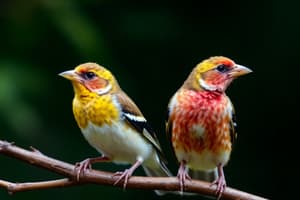Podcast
Questions and Answers
Considering radioactive decay, if a substance has a half-life of 1,500 years, approximately what percentage of the original substance will remain after 6,000 years?
Considering radioactive decay, if a substance has a half-life of 1,500 years, approximately what percentage of the original substance will remain after 6,000 years?
- 6.25% (correct)
- 25%
- 12.5%
- 3.125%
Which of the following scenarios would most likely lead to stabilizing selection?
Which of the following scenarios would most likely lead to stabilizing selection?
- A fish population in a lake diverges into two distinct groups, one feeding in shallow water and the other in deep water.
- A plant species that initially varied widely in height experiences consistent selective pressure favoring medium-sized plants due to wind resistance. (correct)
- A population of birds colonizes a new island with diverse food sources.
- A butterfly population exhibits a shift towards brighter colors due to increased predator avoidance.
In a population of butterflies, wing color is determined by a single gene with two alleles: B (black) and b (white). In generation 1, the allele frequencies are p(B) = 0.6 and q(b) = 0.4. Assuming Hardy-Weinberg equilibrium, what is the expected frequency of heterozygous butterflies (Bb) in generation 2?
In a population of butterflies, wing color is determined by a single gene with two alleles: B (black) and b (white). In generation 1, the allele frequencies are p(B) = 0.6 and q(b) = 0.4. Assuming Hardy-Weinberg equilibrium, what is the expected frequency of heterozygous butterflies (Bb) in generation 2?
- 0.24
- 0.48 (correct)
- 0.36
- 0.16
Which of the descriptions is the most accurate regarding the founder effect, in relation to genetic diversity?
Which of the descriptions is the most accurate regarding the founder effect, in relation to genetic diversity?
Two species of frogs, Rana temporaria and Rana sylvatica, inhabit the same pond. Rana temporaria breeds in early spring, while Rana sylvatica breeds in late spring. Which reproductive isolation is described?
Two species of frogs, Rana temporaria and Rana sylvatica, inhabit the same pond. Rana temporaria breeds in early spring, while Rana sylvatica breeds in late spring. Which reproductive isolation is described?
Which statement most accurately differentiates between artificial selection and natural selection?
Which statement most accurately differentiates between artificial selection and natural selection?
How does the concept of biogeography support the theory of evolution?
How does the concept of biogeography support the theory of evolution?
How do vestigial structures provide evidence for evolution?
How do vestigial structures provide evidence for evolution?
Which scenario would most likely lead to a significant shift in the allele frequencies within a gene pool?
Which scenario would most likely lead to a significant shift in the allele frequencies within a gene pool?
According to evolutionary theory, what is the most accurate interpretation of 'fitness'?
According to evolutionary theory, what is the most accurate interpretation of 'fitness'?
Flashcards
Half Life
Half Life
The time required for half of the radioactive atoms in a sample to decay.
Mutation
Mutation
A change in the DNA sequence of an organism, leading to variations in traits.
Stabilizing Selection
Stabilizing Selection
A type of natural selection that favors average traits and reduces extremes.
Genetic Drift
Genetic Drift
Signup and view all the flashcards
Founders Effect
Founders Effect
Signup and view all the flashcards
Darwin
Darwin
Signup and view all the flashcards
Natural selection
Natural selection
Signup and view all the flashcards
Homologous structures
Homologous structures
Signup and view all the flashcards
Vestigial structures
Vestigial structures
Signup and view all the flashcards
Gene pool
Gene pool
Signup and view all the flashcards
Study Notes
Evolution Exam Study Guide
- Key Concepts: half-life, mutation, stabilizing selection, genetic drift, Hardy-Weinberg principle, geographic isolation, temporal isolation, founders effect.
- Darwin's Views on Fossil Records: The document prompts further study on Darwin's perspective on fossil records.
- Galapagos Finches: The document emphasizes the significance of Galapagos finches in Darwin's research.
- Founder's Effect: The document requests a detailed explanation of how Galapagos finches exemplify the founder's effect.
- Hardy-Weinberg Principle: The document requires understanding the prerequisites for the Hardy-Weinberg principle to hold true.
Studying That Suits You
Use AI to generate personalized quizzes and flashcards to suit your learning preferences.




